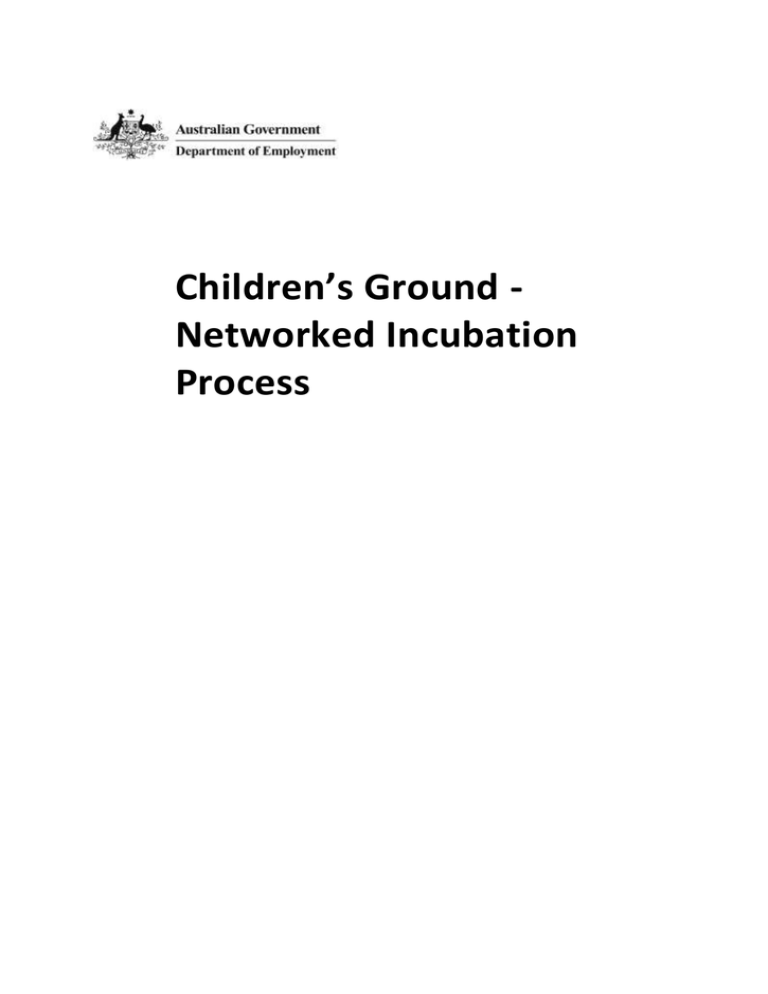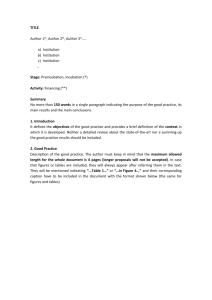Children's Ground – Networked Incubation Process
advertisement

Children’s Ground Networked Incubation Process Children’s Ground – Networked Incubation Process Overview “When you find a unique opportunity to make a real difference, you focus on it and constantly reassess results. This is discipline”1 Networked incubation describes the process of drawing strength from a wide network of organizations and individuals to incubate – or grow and nurture – a vision for change into reality. It imposes a discipline on the process of social innovation and requires a different way of working compared to traditional programme development that challenges and tests the concept in a nonlinear way continually and iteratively throughout its development. Children’s Ground presented an opportunity for ground breaking social change and held real possibility and was found to be a viable candidate for a networked incubation approach for the development of the concept. The Social Innovation team of the department worked with Jane Vadiveloo, an experienced leader of social service reform and founding CEO of Children’s Ground to facilitate this approach. What role did Social Innovation play? ‘The Social Innovation Unit and, within it, the team responsible for undertaking the incubation, consists of only a few people attached to a much larger government agency. A key strength of the Networked Incubation approach has been the Social Innovation Unit’s ability to create capacity beyond the sum of its parts. It utilized its strong global and local networks to broker access to a diverse and relevant range of expertise, wisdom, capability, resources and connections to support the development of Children’s Ground. ‘Timing was important, with different skills required for different stages of the initiative.’2 1 Drucker, P., ‘The Discipline of Innovation’, Harvard Business Review, 2002 Extract from Networked Incubation in Government – A Case Study for Children’s Ground 2013 Liana Downey & Associates Pty Ltd, 2 1 Networked Incubation Process The networked incubation process involved four key steps: 1. The vision Jane Vadiveloo from the outset had a vision grounded in over twenty years of on the ground experience as a practitioner as well as thoroughly researched international evidence and groundbreaking learning on how there was a compelling case for change for some of the most disadvantaged children and their families. Her deep understanding of the complexity of the social issues on the ground helped shape a more systematic and long term approach that would enable a sustainable impact for those experiencing entrenched poverty. The proposal presented to the department was detailed and developed, drawing upon the culmination of that insight, experience and evidence. There were elements drawn from emerging trends internationally as well as the documented evidence for what works. While the vision was compelling, all those involved at the outset of the process acknowledged it would take a great deal of effort and collaboration and time to achieve its full potential. 2. Connecting to the incubator A critical step was connecting the proposition with those who could test, support and had the capacity to assist with its realization. A group of leaders (‘Critical Friends’) from across sectors was brought together in August 2010 at the invitation of the department to test the proposal – starting with the question ‘what would it take to really get a different future for these children’. 2 This group included experienced senior government leaders from a range of government departments. The vision resonated with the group, who agreed there was a strength of proposition here that should be explored, including testing with some serious strategic questions, and that a process was required which went beyond a typical policy or programme development approach, with significantly more flexibility, time and space required for this type of innovation. To facilitate this, Social Innovation was asked to take on the brief. The Social Innovation team’s mandate was to develop and demonstrate new ways of working across sectoral boundaries – to create social impact – just the sort of innovative approach and environment that Children’s Ground required. A process was designed for how an engagement could proceed to take on such an endeavor within the appropriate probity and accountability frameworks to ensure that governance requirements were met within the department’s processes. This included retaining Jane Vadiveloo to collaborate. Through Social Innovation, the department led the incubation and provided the strategic frame in which the work could be developed. Throughout the process there was engagement with a range of stakeholders, particularly the community sector, other Government agencies including the then Department of Families, Housing, Community Services and Indigenous Affairs (FaHCSIA) and a range of Australian and international practitioners and experts. 3. Networked Incubation – from vision to actionable model The incubation focus provided the environment and support to enable Children’s Ground to develop and grow. Building on the ‘safe space’ created at the first meeting of critical friends, the Social Innovation team was actively engaged with Jane Vadiveloo and created a supportive but challenging atmosphere, characterized by rigour, excellence and strategic intent. Social Innovation’s role was required to hold the strategic vision while addressing the practical dimensions of how to bring it to life in a dynamic and non-linear process. Throughout the incubation process Social Innovation continually reinforced and drove a process of concept development and testing including referring and consulting with experts, gathering evidence and commissioning research to verify what would apply in the Australian context and to test the veracity of the way in which the international evidence base was being interpreted and applied for Australia (see for example the Murdoch Research Report3 ). With Social Innovation acting as a broker and holding a stratetic vision, the critical elements of this process included: research drivers of success asking and answering penetrating questions iterating and refining the strategy and model designing and supporting resilient structures building a network of experties and support. 3 Centre for Community Child Health, Murdoch Children’s Research Institute in Collaboration with the Royal Children’s Hospital Education Institute, ‘Review of the evidence base in relation to early childhood approaches to support children in highly disadvantaged communities for the Children’s Ground Project’, 2011 3 This phase involved a process of continual testing, refining and developing the model while holding the strategic vision for Children’s Ground at the same time. 4. Transitioning out of the incubator and commencing implementation The final step in the networked incubation process was transitioning Children’s Ground out of the incubation process towards independence. Determining a point where enough work had been done and Children’s Ground was ready to roll out of the incubation process and needed to shift focus from strategy and design to implementation required a great degree of judgment and faith amongst all involved. A large part of the decision was balancing the need to further test the model in the community and getting the thinking and strategy right. To achieve this, Social Innovation arranged further meetings with the Critical Friends and other senior stakeholders to test whether the model and action plan in place were sufficiently complete and robust to make that transition. In order to realize full value from the investment in strategic development of the approach and to create a framework for learning, a Community of Practice was set up in partnership between the department and Children’s Ground. 4 Reflections from key stakeholders Children’ Ground Approach Key Themes Value of community agency Harnessing and building community strength New and innovative approach to governance of programmes Need to develop a wider range of models with cross sector involvement to encourage social innovation Look at models outside government for inspiration Hand of government should guide, convene, facilitate and foster social innovation from within the community To scale social innovation need to think about the government to play a role ‘I liked the idea of the pursuit of excellence and not accepting second best and ensuring that once you accepted a child into the programme you give them everything they need to be successful. You do it in the context of their extended family because it is not just a child. It is actually their conditions at home and the situation of their siblings, parents and grandparents which will actually make or break whether they are successful…’ ‘I had the view that if you took a bottom up place based approach you would fundamentally change the future of not only the individual but also their communities.’ Jeff Whalen, AO (Children’s Ground Critical Friend) Managing Director -Jeff Whalen Learning Group ‘I was drawn to Children’s Ground in part because I knew Robert Griew4 was passionate about innovation – not just in programmes or practice but particularly in governance i.e., can’t just have another intervention working with the mechanics and governance of government otherwise we’d fail and I saw it tried to engage differently on the ground with complexity.’ Chris Gration (Children’s Ground Critical Friend) 4 the Associate Secretary at the time 5 Reflections on the Incubation Process Key Themes Different way of working therefore different capabilities required Funding and resources are a significant driver, but should not be the only focus Holding the vision and managing complexity and ambiguity Lack of formal structures to facilitate work across government agencies Breadth of view (and span of control) of senior public servants is significant Untapped potential pool of talent inside public service Need to get better at knowing what is going on ‘out there’ i.e., in the community – to understand what the issues are People – leadership, capability, local Product – Governance, Measurement and Evidence Process – Networked incubation, safe space ‘So many unique challenges, situations, roadblocks and barriers it is amazing it has gotten to where it is today – lots of things I didn’t think would happen, did happen … (and) personally I have become more patient and empathetic to the complexity of social innovation and the number of people and skill sets required.’ Seri Renkin (former Children’s Ground Project Director) CEO Gordon Care ‘People have to go on a journey in understanding Children’s Ground – it takes people a long time to get their head around it and they tend to enter with their own reference point’ Jane Vadiveloo Children’s Ground Visionary ‘What the Social Innovation Unit did looks like an example of co-production, they didn’t decide beforehand what it should look like and were working with the community and service providers to determine what it should look like.’ Tim Moore, Senior Research Fellow at the Centre for Community Child Health at the Murdoch Children’s Research Institute 6








